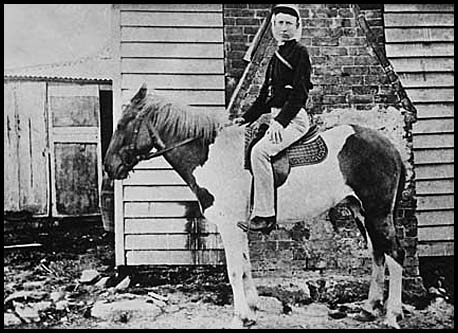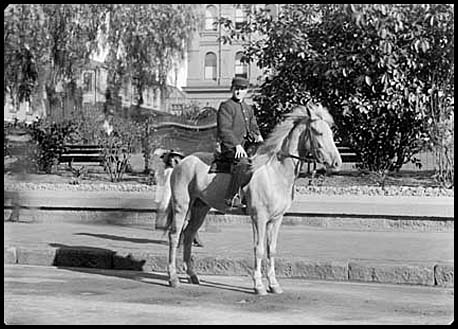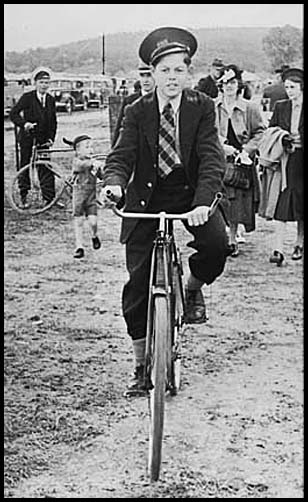Telegram Messengers - modes of transport.
- Home, index, site details
- Australia 1901-1988
- New South Wales
- Overview of NSW
- Telegraph lines
- Telegraph Offices
- Date stamps
- Forms
- Envelopes
- Rates
- Stamps
- Queensland
- Overview of Qld
- Telegraph lines
- Telegraph offices
- Date stamps
- Forms
- Envelopes
- Rates
- Stamps
- South Australia
- Overview of SA
- Telegraph lines
- Telegraph Offices
- Date stamps
- Forms
- Envelopes
- Rates
- Stamps
- Tasmania
- Overview of Tasmania
- General developments
- Reports
- Organisation
- Telegraph lines
- Telegraph Offices
- Date stamps
- Railway lines
- Forms
- Envelopes
- Rates
- Stamps
- Overview of Tasmania
- Victoria
- Overview of Vic.
- Telegraph lines
- Telegraph offices
- Date stamps
- Forms
- Envelopes
- Rates
- Stamps
- Ephemera
- Western Australia
- Overview of WA
- Telegraph lines
- Telegraph Offices
- Date stamps
- Forms
- Envelopes
- Rates
- Stamps
Although there had been considerable technological development to enable the transmission of a message across large distances, the last stage of the process still depended on the message being delivered to the recipient. Generally that task was fulfilled by a young boy between the ages of 14 and 16.
From early days, Telegraph Messengers used a variety of modes of transport. The most common mode was walking and the messengers were allocated a time to walk to a particular place, deliver the message and return. On occasions, walking could be dangerous - especially in country areas. For example, the Northern Miner of 1 December 1881 reported "news was received last night from Norwood stating that a telegraph messenger, sent some distance with a message for a man Easton, had lost his way and was found dead - having perished of thirst".
Other mode of transport were:
- horses;
- bicycles;
- motor bikes;
- cabs of all descriptions;
- boats;
The horse was a standard "item of equipment" in the telegraph office. A typical description of an office would be :
as having .. rooms, and a stable for 20 horses.
 Mounted Telegraph Messenger on his horse outside the Brisbane GPO in 1890. |
 Mounted Telegraph Messenger on his horse in 1900. |
 One of the six designs in the Australia Post and Telegraph series published by Raphael Tuck &Sons under its world-wide Oilette Series. This Australian series, signed by A. H. Fullwood, depicts a variety of postal (delivery) scenes throughout Australia in the late 1800s. |
|
A typical image of a Telegraph Messenger in uniform riding to deliver a telegram. The black strap across his chest held the delivery bag. The red pillar box for posting letters can be see to the right of the horse.
|
|
 Lithograph extract from the 1884 Picturesque Atlas of Australasia. |
Another view of a Messenger going to a delivery. His bag is clearly on view in this image. |
In some places, horses were used to bridge a gap in a line still under construction. Examples of this use of horses are:
- the final gap in the Overland Telegraph Line;
- the construction of the telegraph line in the Pilbara region of Western Australia beyond Onslow (then named Ashburton).
Horses did not guarantee the safety of a messenger. For example, in Melbourne in December 1873, there was a heavy downfall of rain and Elizabeth Street quickly became flooded. "A mounted telegraph messenger attempted to cross the street and his horse was washed off its legs in one of the channels and the messenger would doubtless have been drowned had it not been for the successful and courageous exertions of a cabman named McCarthy who was assisted by Constable Connelly".
Telegraph delivery - the domain of young boys and animals - was an area in which irrational "cost-savings" were often attempted or poor decision making made. The salaries paid to messengers are discussed elsewhere. Another example was reported in the Illawarra Mercury of 10 March 1882:
"THE TELEGRAPH MESSENGER — A very important matter in connection with the telegraph service in this town may be said to have been overlooked for a length of time by the interested public. We allude to the fact of the telegraph messenger connected with the Wollongong office not being allowed forage for a horse with which to deliver messages as expeditiously as should be done.
The great value and purpose of a telegraphic agency is quick delivery of messages and yet the arrangements for delivery from the Wollongong office is so imperfect in one respect that in not a few instances, the object of the service is defeated and disappointment, inconvenience and sometimes actual loss are occasioned to individuals. In consequence of the messenger, whoever he may be, not having a horse allowed him, he has to deliver telegrams on foot unless he borrows from a friend or hires one. As a consequence of this, considerable delay frequently takes place in the delivery of messages.
For instance, if a telegram for a vessel in the harbor arrives just after the messenger has started on foot with a message to the west end of the town - say to Wilshire's Hill - the delivery of the former has to be delayed until the return of the messenger after having walked very nearly two miles. Meanwhile, it may be (as has happened frequently) that the vessel to which the other telegram was addressed has left without receiving the instructions wired to her. Serious instances such as this have occurred very often and will recur over and over again unless the paltry allowance required for the keep of a horse to deliver messages from the office be granted.
Forage allowance is given the letter carrier from the same office although his runs do not average two a day round the town whereas the telegraph messenger, who may be kept going all day from the opening to the closing of the office, is left to do all his travelling on foot, so far as the authorities are concerned. The thing is so unreasonable, more especially in connection with a shipping port of such importance as is Wollongong, that we cannot believe more requires to be done to have it remedied than to represent the matter properly to the Postmaster-General either by memorial from the inhabitants interested or by request from the Borough Council or the member for the district".
Unbelievably this was a common issue. The Cootamundra Herald of 18 March 1882 noted:
"Success at Last — Our Vigilance Committee, in correspondence with the public departments, follows the advice of the old nursery rhyme 'If at first you don't succeed, try, try, try again.'
They have been many months trying to get a horse for the telegraph messenger and, by dint of perseverance against the opposition of the officials, have at last succeeded in their object. The department has allowed a sum per annum for a horse and now we get our messages delivered in something like reasonable time".
Enough of these stories.
 Queensland messenger with bike - 1890. |
 NSW messenger on bike - 1938. |
New South Wales:
In December 1880, the NSW Telegraph Office announced that messengers would be now using tricycles instead of horses. No other information is available on this development.
Victoria:
Bicycles were introduced in Victoria for Telegram Messengers in 1890 - the bikes being hired for the purpose. This simple innovation made the whole process much faster and had a significant benefit-cost ratio - even higher than the telegraph investments themselves.
In 1897, with the object of securing more rapid delivery of telegrams in suburban and country districts, the Postal Dept. proposed "to encourage telegraph messengers to use bicycles. It was announced that at suburban and country offices, those messengers who own bicycles and constantly use them for the delivery of telegrams will be granted an allowance of £9 per annum for the maintenance of machines. Consequent on this offer, postmasters are to ascertain whether any of the messengers attached to their offices are willing to purchase bicycles on these conditions and to report as to what extent the delivery of telegrams will be facilitated and whether this will enable the messengers' staff to be reduced, and to what extent".
Queensland:
In Queensland, the Rockhampton Morning Bulletin of 13 December 1899 announced that "The messengers in the Telegraph Office were provided yesterday with several Massey-Harris bicycles for use in the delivery of telegraphic messages in the town. The Massey-Harris Company have secured the contract for a term of three years to supply the Queensland Government with their bicycles for the use of officials in the Government service, such as postmen, telegraph messengers, &c.
The Massey-Harris Company have also the contracts with the Victorian and New Zealand Governments to supply the police and post and telegraphic officials with Massey-Harris bicycles as they are required. The company also undertakes to keep the bicycle in good repair during the term of the contract.
Messrs. A. E. Beal and Co., the Rockhampton agents, are offering a prize of a gold medal to the telegraph messenger who takes the best care of his machine".
In country areas especially but also within some parts of the cities, motor bikes were introduced to enable the messengers to travel to more distant places or to travel more quickly over hilly terrain. The bikes were not powerful but were effective (sometimes effective in more ways than one).